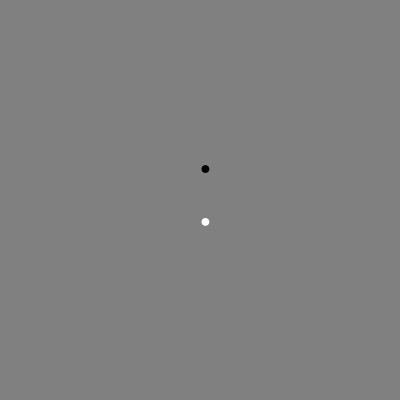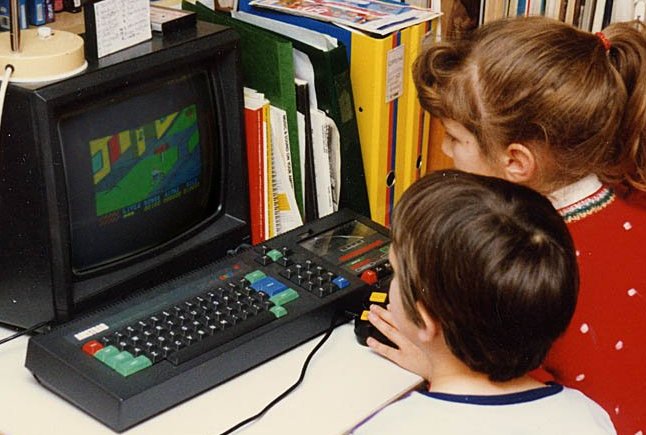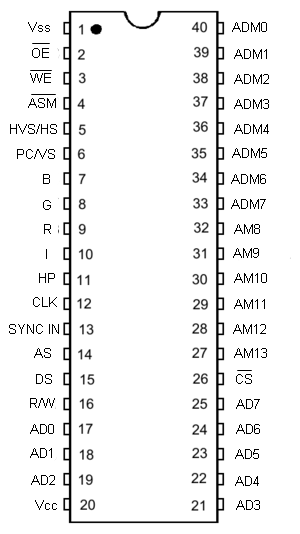|
TEA1002
The TEA1002 is a PAL video encoder chip produced by Mullard in 1982 and used on the Mattel Aquarius and AlphaTantel computers. It was also used on teletext decoders and color bar generators associated with video test equipment The chip is capable of displaying 320 x 192 pixels (within borders), 40x24 text blocks (with 8 x 8 pixel character block) and 80x72 addressable graphics. It generates 16 colors based on Luminance, Chrominance and Saturation with the 8 basic colors being similar to the EBU 75% color bars. Levels According to the TEA1002 datasheet, colors are formed by the combination of three signals: Luminance, Chrominance and Saturation. The following table lists the internal signals and shows an approximation of the generated colors, as seen on a web standard sRGB monitor. Colors could be different when seen on an analog NTSC or PAL CRT television. Internally colors are stored in a 4 bit RGBI arrangement. There are three bits for the RGB components (generating 8 p ... [...More Info...] [...Related Items...] OR: [Wikipedia] [Google] [Baidu] |
List Of Monochrome And RGB Color Formats
This list of monochrome and RGB palettes includes generic repertoires of colors ( color palettes) to produce black-and-white and RGB color pictures by a computer's display hardware. RGB is the most common method to produce colors for displays; so these complete RGB color repertoires have every possible combination of R-G-B triplets within any given maximum number of levels per component. Each palette is represented by a series of color patches. When the number of colors is low, a 1-pixel-size version of the palette appears below it, for easily comparing relative palette sizes. Huge palettes are given directly in one-color-per-pixel color patches. For each unique palette, an image color test chart and sample image ( truecolor original follows) rendered with that palette (without dithering) are given. The test chart shows the full 256 levels of the red, green, and blue (RGB) primary colors and cyan, magenta, and yellow complementary colors, along with a full 256-level grayscale. G ... [...More Info...] [...Related Items...] OR: [Wikipedia] [Google] [Baidu] |
Mattel Aquarius
Aquarius is a home computer designed by Radofin and released by Mattel Electronics in 1983. Based on the Zilog Z80 microprocessor, the system has a rubber chiclet keyboard, 4K of RAM, and a subset of Microsoft BASIC in ROM. It connects to a television set for audiovisual output, and uses a cassette tape recorder for secondary data storage. A limited number of peripherals, such as a 40-column thermal printer, a 4-color printer/plotter, and a 300 baud modem, were released. The Aquarius was discontinued in October 1983, only a few months after it was launched. Development Looking to compete in the home computer market, Mattel Electronics turned to Radofin, the Hong Kong based manufacturer of their Intellivision consoles. Radofin had designed two computer systems. Internally they were known as "Checkers" and the more sophisticated "Chess". Mattel contracted for these to become the Aquarius and Aquarius II, respectively. Aquarius was announced in 1982 and finally released in June 1 ... [...More Info...] [...Related Items...] OR: [Wikipedia] [Google] [Baidu] |
List Of Home Computers By Video Hardware
This is a list of home computers, sorted alphanumerically, which lists all relevant details of their video hardware. Home computers are the second generation of desktop computers, entering the market in 1977 and becoming common during the 1980s. A decade later they were generally replaced by IBM PC compatible "PCs", although technically home computers are also classified as personal computers. Examples of typical early home computers are the TRS-80, Atari 400/800, BBC Micro, the ZX Spectrum, the MSX 1, the Amstrad CPC 464 and the Commodore 64. Examples of typical late home computers are MSX 2 systems, and the Amiga and Atari ST systems. Note: in cases of manufacturers who have made both home and personal computers, only machines fitting into the ''home'' computer category are listed. Systems in the personal computer category, except for Early Macintosh PCs, are generally based on the VGA standard and use a video chip known as a Graphics Processing Unit. Very early PCs used on ... [...More Info...] [...Related Items...] OR: [Wikipedia] [Google] [Baidu] |
MOS Technology VIC-II
The VIC-II (Video Interface Chip II), specifically known as the MOS Technology 6567/8562/8564 (NTSC versions), 6569/8565/8566 (PAL), is the microchip tasked with generating Y/C video signals (combined to composite video in the RF modulator) and DRAM refresh signals in the Commodore 64 and C128 home computers. Succeeding MOS's original VIC (used in the VIC-20), the VIC-II was one of the two chips mainly responsible for the C64's success (the other chip being the 6581 SID). Development history The VIC-II chip was designed primarily by Al Charpentier and Charles Winterble at MOS Technology, Inc. as a successor to the MOS Technology 6560 "VIC". The team at MOS Technology had previously failed to produce two graphics chips named ''MOS Technology 6562'' for the Commodore TOI computer, and ''MOS Technology 6564'' for the Color PET, due to memory speed constraints. In order to construct the VIC-II, Charpentier and Winterble made a market survey of current home computers and video ... [...More Info...] [...Related Items...] OR: [Wikipedia] [Google] [Baidu] |
TMS9918
IMAGE:TMS9918A 01.jpg, VDP TMS9918A IMAGE:TMS9918A 02.jpg, VDP TMS9918A IMAGE:TMS9928A 01.jpg, VDP TMS9928A The TMS9918 is a video display controller (VDC) manufactured by Texas Instruments, in manuals referenced as 'Video Display Processor' (VDP) and introduced in 1979. The TMS9918 and its variants were used in the ColecoVision, CreatiVision, Memotech MTX, MSX, NABU Network#Hardware, NABU Personal Computer, SG-1000/SC-3000, Spectravideo SV-318, Spectravideo SV-328, Sord M5, Tatung Einstein, Texas Instruments TI-99/4, Casio PV-1000#PV-2000, Casio PV-2000, Coleco Adam, Hanimex, Hanimex Pencil II, and Tomy Tutor. The TMS9918 generates both grid-based character graphics (used to display text or background images) and sprite (computer graphics), sprites used for moving foreground objects. The key features of this chip are, as highlighted on a 1980 presentation by Karl Guttag (one of the designers): *256 by 192 full color pixels per screen *15 different colors and/or shades *Progress ... [...More Info...] [...Related Items...] OR: [Wikipedia] [Google] [Baidu] |
Motorola 6845
The Motorola 6845, or MC6845, is a display controller that was widely used in 8-bit computers during the 1980s. Originally intended for designs based on the Motorola 6800 CPU and given a related part number, it was more widely used alongside various other processors, and was most commonly found in machines based on the Zilog Z80 and MOS 6502. The 6845 is not an entire display solution on its own; the chip's main function is to properly time access to the display memory, and to calculate the memory address of the next portion to be drawn. Other circuitry in the machine then uses the address provided by the 6845 to fetch the pattern and then draw it. The implementation of that hardware is entirely up to the designer and varied widely among machines. The 6845 is intended for character displays, but could also be used for pixel-based graphics, with some clever programming. Among its better-known uses is the BBC Micro, Amstrad CPC, and Videx VideoTerm display cards for the Apple II ... [...More Info...] [...Related Items...] OR: [Wikipedia] [Google] [Baidu] |
Thomson EF9345
The EF9345 from SGS-Thomson Microelectronics, Inc., was a semigraphic microprocessor for video image control, encapsulated in a 40-pin DIP and used primarily in the Matra Alice 32, Matra Alice 90 and Philips VG5000 microcomputers. The EF9345 was capable of displaying 8 colors ( RGB primaries), 128 alphanumeric characters and 128 semigraphic characters. It had one semigraphic mode and 40- and 80-column text modes. It was able to address up to 16KB of dedicated video RAM. Video Modes * 50/60Hz output ** Interlaced or progressive scan *Semigraphics: ** 128 standard character set with 5x7 pixel font dimensions. User definable 8x10 pixel alphanumeric or semigraphic sets. *40 characters x 25 rows text mode (similar to teletext): ** 8 x 10 pixel font ** Selectable background and foreground colors ** Styles: double height, double width, blinking, reverse, underline, conceal, insert, accentuation of lowercase characters *80 characters x 25 rows text mode: ** 6 x 10 pixel font ** Styles: ... [...More Info...] [...Related Items...] OR: [Wikipedia] [Google] [Baidu] |
Television Set
A television set or television receiver, more commonly called the television, TV, TV set, telly, tele, or tube, is a device that combines a tuner, display, and loudspeakers, for the purpose of viewing and hearing television broadcasts, or using it as a computer monitor. Introduced in the late 1920s in Mechanical television, mechanical form, television sets became a popular consumer product after World War II in electronic form, using cathode ray tube (CRT) technology. The addition of color to broadcast television after 1953 further increased the popularity of television sets in the 1960s, and an outdoor antenna became a common feature of suburban homes. The ubiquitous television set became the display device for the first recorded media in the 1970s, such as , VHS and later DVD. It has been used as a display device since the first generation of (e.g. Timex Sinclair 1000) and dedicated video game consoles (e.g. Atari) in the 1980s. By the early 2010s, flat-panel television incorp ... [...More Info...] [...Related Items...] OR: [Wikipedia] [Google] [Baidu] |
Cathode-ray Tube
A cathode-ray tube (CRT) is a vacuum tube containing one or more electron guns, which emit electron beams that are manipulated to display images on a phosphorescent screen. The images may represent electrical waveforms (oscilloscope), pictures (television set, computer monitor), radar targets, or other phenomena. A CRT on a television set is commonly called a picture tube. CRTs have also been used as memory devices, in which case the screen is not intended to be visible to an observer. The term ''cathode ray'' was used to describe electron beams when they were first discovered, before it was understood that what was emitted from the cathode was a beam of electrons. In CRT television sets and computer monitors, the entire front area of the tube is scanned repeatedly and systematically in a fixed pattern called a raster. In color devices, an image is produced by controlling the intensity of each of three electron beams, one for each additive primary color (red, green, and blue ... [...More Info...] [...Related Items...] OR: [Wikipedia] [Google] [Baidu] |
Mullard
Mullard Limited was a British manufacturer of electronic components. The Mullard Radio Valve Co. Ltd. of Southfields, London, was founded in 1920 by Captain Stanley R. Mullard, who had previously designed thermionic valves for the Admiralty before becoming managing director of the Z Electric Lamp Co. The company soon moved to Hammersmith, London and then in 1923 to Balham, London. The head office in later years was Mullard House at 1–19 Torrington Place, Bloomsbury, now part of University College London. Start-up In 1921, the directors were Sir Ralph Ashton (chairman), Basil Binyon of the Radio Communication Co, C.F. Elwell and S.R. Mullard (Managing Director). Partnership with Philips In 1923, to meet the technical demands of the newly formed BBC, Mullard formed a partnership with the Dutch manufacturer Philips. The valves (vacuum tubes) produced in this period were named with the prefix PM, for Philips-Mullard, beginning with the PM3 and PM4 in 1926. Mullard fina ... [...More Info...] [...Related Items...] OR: [Wikipedia] [Google] [Baidu] |
SRGB
sRGB is a standard RGB (red, green, blue) color space that HP and Microsoft created cooperatively in 1996 to use on monitors, printers, and the World Wide Web. It was subsequently standardized by the International Electrotechnical Commission (IEC) as IEC 61966-2-1:1999. sRGB is the current defined standard colorspace for the web, and it is usually the assumed colorspace for images that are neither tagged for a colorspace nor have an embedded color profile. sRGB essentially codifies the display specifications for the computer monitors in use at that time, which greatly aided its acceptance. sRGB uses the same color primaries and white point as ITU-R BT.709 standard for HDTV, a transfer function (or gamma) compatible with the era's CRT displays, and a viewing environment designed to match typical home and office viewing conditions. An amendment of the IEC 61966-2-1 standard document that defines sRGB includes the definition of a number of variants including sYCC, which is a ... [...More Info...] [...Related Items...] OR: [Wikipedia] [Google] [Baidu] |
EBU Colour Bars
The EBU colour bars is a television test card used to check if a video signal has been altered by recording or transmission, and what adjustments must be made to bring it back to specification. It is also used for setting a television monitor or receiver to reproduce chrominance and luminance information correctly. The EBU bars are most commonly shown arranged side-by-side in a vertical manner (as in the images in this article), though some broadcasters – such as TVP in Poland, and Gabon Télévision in Gabon – were known to have aired a horizontal version of the EBU bars. It is similar to the SMPTE color bars, although that pattern is typically associated with the NTSC analogue colour TV system. Many test cards, such as Philips PM5544 or Telefunken FuBK, feature elements equivalent to the EBU colour bars. 75% Colour Bars The 75% Colour Bars or EBU/ IBA 100/0/75/0 Colour Bars pattern is very similar to the SMPTE colour bars pattern, although it only features seven colou ... [...More Info...] [...Related Items...] OR: [Wikipedia] [Google] [Baidu] |




